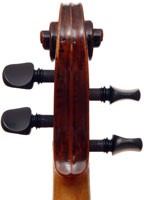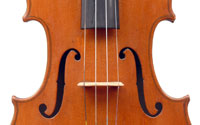|
Ref : 0879
A good German trade violin.
|

go to Home Page see more Violins |
The English authority William Henley confirms in his book something which is quite evident concerning the numberous German trade instruments labelled Johann Baptiste Schweitzer - with reference to this label he states: 'Trade name used extensively by factory merchants in Saxony and the Tyrol. Commonplace imitations of [Schweitzer]'s style.'Such instruments were usually aimed at the amateur and student market. Over several years I have been contacted by several people in South Africa who own violins with precisely the same label (usually dated 1813) and similar characteristics.
This violin bears such a label, but despite that it is a well-made instrument and very well-toned with a robust responsive and focussed sound. Probably made around 1910 or a bit later, it has spent most of its existence in professional use.
It is made of good materials - a finely-grained spruce top and an attractive one-piece maple back. All round the workmanship is good.
This violin has seen repairs to three cracks in the top, ostensibly professionally carried out and secure. However, the entire body has been stripped of its original varnish and revarnished in a light brown colour. The original varnish, which is still evident on the scroll, was a dark brown. Such revarnishing is often the consequence of a failure by a maker to match the original varnish when touching up cracks and repairs and then resorting to stripping off all the original varnish and revarnishing the entire instrument, thereby avoiding the problem of matching colours. Although usually well-intentioned, this practice is not without consequences for the instrument's value.
This violin is in good condition and structurally secure. It just received a new set of ebony pegs and a Hill-type tailpiece. It should serve for many decades to come.
It is a pleasant instrument to play on, as it is very responsive with a big tone.
 |
 |
 |
||
 |
Dimensions : Length of back: 36.0 cm
Condition : Three cracks in the top have been professionally repaired. Newly fitted with ebony pegs and Hill style tailpiece.
The body of the violin has been stripped of the original varnish and revarnished. The scroll till has the original varnish.
The violin is structurally secure and in good condition.
Provenance : Withheld. This violin has been in professional use for a number of years until recently
Price : R25 000 Approximately US$ 1 820.
This price is based on the accepted price structure for good German trade instruments and also takes into account that the violin has repaired cracks and has been revarnished.
 |
 |
 |
 |
 |
 |
 |
 |
 |
 |
 |
 |
|||||
 |